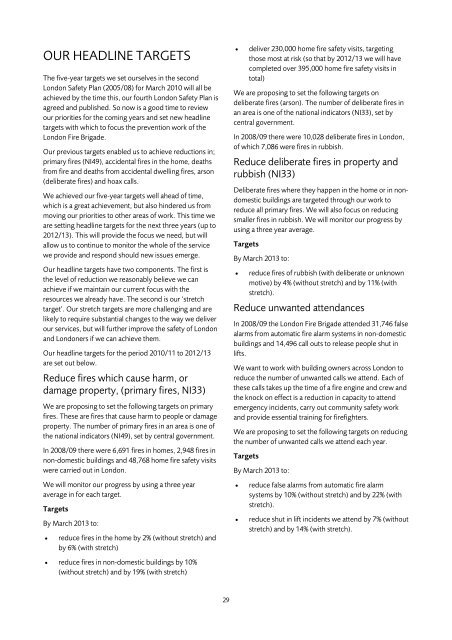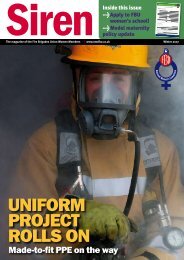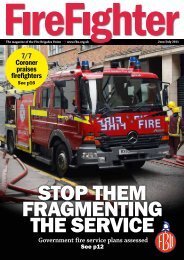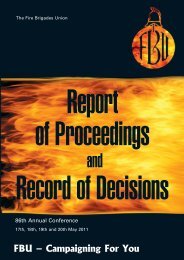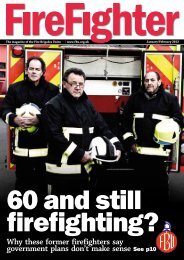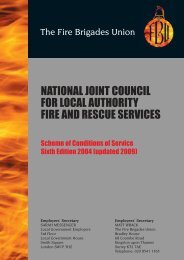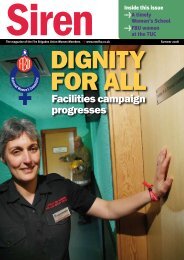Draft London Safety Plan 2010/2013 - Fire Brigades Union London
Draft London Safety Plan 2010/2013 - Fire Brigades Union London
Draft London Safety Plan 2010/2013 - Fire Brigades Union London
Create successful ePaper yourself
Turn your PDF publications into a flip-book with our unique Google optimized e-Paper software.
OUR HEADLINE TARGETS<br />
The five-year targets we set ourselves in the second<br />
<strong>London</strong> <strong>Safety</strong> <strong>Plan</strong> (2005/08) for March <strong>2010</strong> will all be<br />
achieved by the time this, our fourth <strong>London</strong> <strong>Safety</strong> <strong>Plan</strong> is<br />
agreed and published. So now is a good time to review<br />
our priorities for the coming years and set new headline<br />
targets with which to focus the prevention work of the<br />
<strong>London</strong> <strong>Fire</strong> Brigade.<br />
Our previous targets enabled us to achieve reductions in;<br />
primary fires (NI49), accidental fires in the home, deaths<br />
from fire and deaths from accidental dwelling fires, arson<br />
(deliberate fires) and hoax calls.<br />
We achieved our five-year targets well ahead of time,<br />
which is a great achievement, but also hindered us from<br />
moving our priorities to other areas of work. This time we<br />
are setting headline targets for the next three years (up to<br />
2012/13). This will provide the focus we need, but will<br />
allow us to continue to monitor the whole of the service<br />
we provide and respond should new issues emerge.<br />
Our headline targets have two components. The first is<br />
the level of reduction we reasonably believe we can<br />
achieve if we maintain our current focus with the<br />
resources we already have. The second is our ‘stretch<br />
target’. Our stretch targets are more challenging and are<br />
likely to require substantial changes to the way we deliver<br />
our services, but will further improve the safety of <strong>London</strong><br />
and <strong>London</strong>ers if we can achieve them.<br />
Our headline targets for the period <strong>2010</strong>/11 to 2012/13<br />
are set out below.<br />
Reduce fires which cause harm, or<br />
damage property, (primary fires, NI33)<br />
We are proposing to set the following targets on primary<br />
fires. These are fires that cause harm to people or damage<br />
property. The number of primary fires in an area is one of<br />
the national indicators (NI49), set by central government.<br />
In 2008/09 there were 6,691 fires in homes, 2,948 fires in<br />
non-domestic buildings and 48,768 home fire safety visits<br />
were carried out in <strong>London</strong>.<br />
We will monitor our progress by using a three year<br />
average in for each target.<br />
Targets<br />
By March <strong>2013</strong> to:<br />
<br />
reduce fires in the home by 2% (without stretch) and<br />
by 6% (with stretch)<br />
reduce fires in non-domestic buildings by 10%<br />
(without stretch) and by 19% (with stretch)<br />
<br />
deliver 230,000 home fire safety visits, targeting<br />
those most at risk (so that by 2012/13 we will have<br />
completed over 395,000 home fire safety visits in<br />
total)<br />
We are proposing to set the following targets on<br />
deliberate fires (arson). The number of deliberate fires in<br />
an area is one of the national indicators (NI33), set by<br />
central government.<br />
In 2008/09 there were 10,028 deliberate fires in <strong>London</strong>,<br />
of which 7,086 were fires in rubbish.<br />
Reduce deliberate fires in property and<br />
rubbish (NI33)<br />
Deliberate fires where they happen in the home or in nondomestic<br />
buildings are targeted through our work to<br />
reduce all primary fires. We will also focus on reducing<br />
smaller fires in rubbish. We will monitor our progress by<br />
using a three year average.<br />
Targets<br />
By March <strong>2013</strong> to:<br />
<br />
reduce fires of rubbish (with deliberate or unknown<br />
motive) by 4% (without stretch) and by 11% (with<br />
stretch).<br />
Reduce unwanted attendances<br />
In 2008/09 the <strong>London</strong> <strong>Fire</strong> Brigade attended 31,746 false<br />
alarms from automatic fire alarm systems in non-domestic<br />
buildings and 14,496 call outs to release people shut in<br />
lifts.<br />
We want to work with building owners across <strong>London</strong> to<br />
reduce the number of unwanted calls we attend. Each of<br />
these calls takes up the time of a fire engine and crew and<br />
the knock on effect is a reduction in capacity to attend<br />
emergency incidents, carry out community safety work<br />
and provide essential training for firefighters.<br />
We are proposing to set the following targets on reducing<br />
the number of unwanted calls we attend each year.<br />
Targets<br />
By March <strong>2013</strong> to:<br />
<br />
<br />
reduce false alarms from automatic fire alarm<br />
systems by 10% (without stretch) and by 22% (with<br />
stretch).<br />
reduce shut in lift incidents we attend by 7% (without<br />
stretch) and by 14% (with stretch).<br />
29


